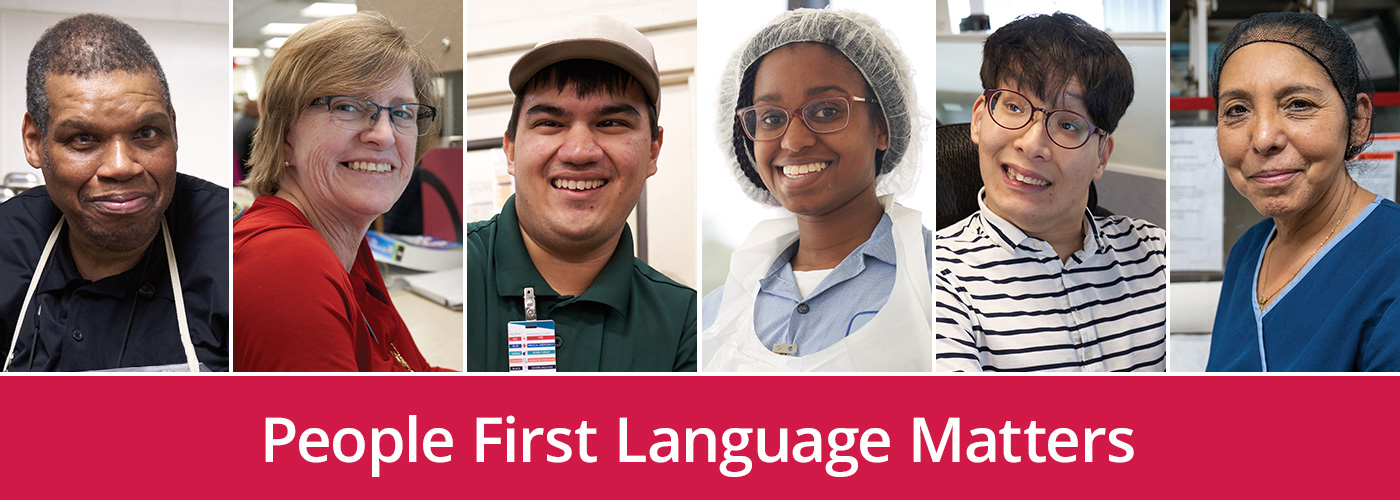The importance of "people first" language

Language is always evolving. As writers, it’s important that we stay mindful of how our words will impact the hundreds, and even thousands, of people that read our articles and blogs. Our words can have a ripple effect, potentially reinforcing misconceptions or inadvertently changing minds.
We often think of accessibility in terms of structural design and technology. However, it often takes a back seat in how we write and communicate about people with disabilities. At SourceAmerica, we connect over 80,000 professionals with disabilities with jobs through our national network of member nonprofit agencies. We want to elevate and highlight the talents of these professionals through content-like feature articles and online videos in order to create more job opportunities.
Our role as a connector, educator and advocate means SourceAmerica has a significant responsibility to ensure that when we are communicating, it is always "people first."
Defining People First Language
The best way to refer to a person with a disability when writing a feature piece is simply to use their name. If they prefer their name is not publicized, people first language should take front and center (we’ll get to that in a minute!). Let's remember that people with disabilities are mothers, fathers, grandparents, sons, daughters and so much more.
A person with a disability is just that – a person first and foremost. Their disability is only one part of their identity. Instead of referring to people based on a medical diagnosis, we should use people first language to explain what a person HAS; not what a person IS. For example, John Smith has epilepsy instead of John Smith is epileptic.
Placing the person first and the disability second helps eliminate stereotypes that can form, and it emphasizes the individuality, equality, and dignity of these individuals. Sentences that include terms like "the disabled" neglect the human aspect of a person’s disability. Another aspect of people first language to be mindful of is that words such as afflicted with, suffers from, and victim of may imply tragedy.
While it can seem wordy to say "a person with a disability" vs. "a disabled person," it demonstrates respect. Whether you’re writing or talking about these talented individuals, it’s important to keep the following tips in mind:
Examples of People First Language
Education is the first step in awareness. Below are some examples of positive ways to use people first language.
| Use this language | Do not use this language |
|---|---|
| People with disabilities | The handicapped, the disabled |
| People without disabilities | Normal, healthy, whole or typical people |
| Person with a developmental disability | Person afflicted with, suffers from, a victim of… |
| Person who is blind, person who is visually impaired | The blind |
| Person with cerebral palsy | Cerebral palsy victim |
| Person with epilepsy | Epileptic |
| Person who uses a wheelchair | Confined or restricted to a wheelchair |
| Person with a physical disability | Crippled, lame, deformed |
| Unable to speak, uses synthetic speech | Dumb, mute |
More examples can be found by searching online for "people first language." This list is intended as general guidance, but individual preference for specific language will vary. If you’re ever in doubt, ask people what terminology they would prefer.
By using people first language in our content, we are acknowledging that an individual’s disability is just one part of their life, and we can begin to eliminate misconceptions to create a more inclusive society.
If you’re interested in testing your people first language skills, take our quiz!
To learn more about SourceAmerica and our network of nonprofit agencies please contact customerservice@sourceamerica.org.